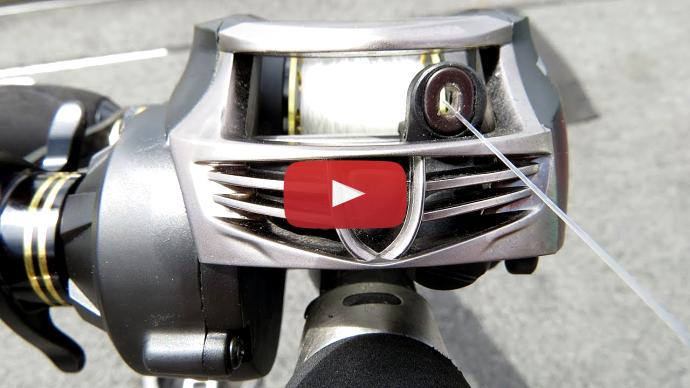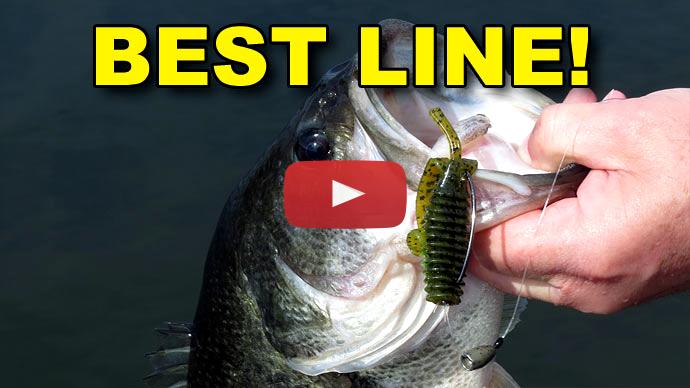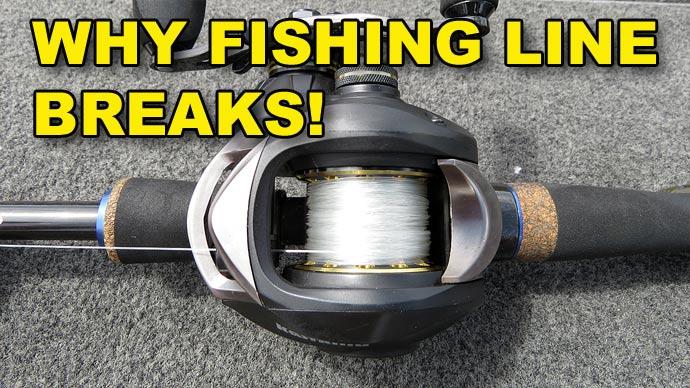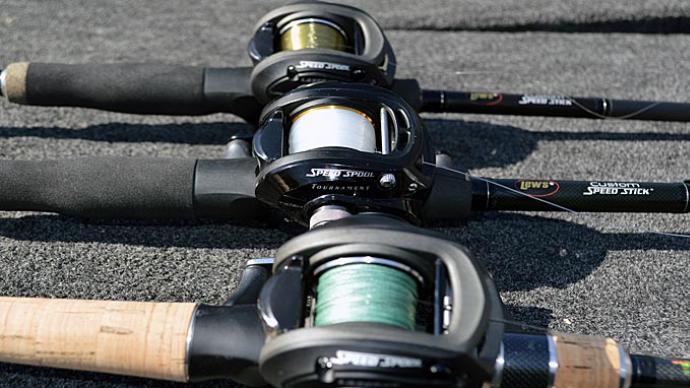Hey folks, Glenn May here with BassResource.com. Today, the wind kinda blew us off the main lake so I wanted to talk to you about different lines and choosing the different line types for various kinds of bass fishing. So, it really makes a big difference in your success because line, it determines your feel on the baits you use, it determines their presentation. And of course, it matters in whether or not you actually catch the fish hooksets, get them in a boat, you can lose fish, you could break line off. So, it's really critical that you choose the right kind of line for the technique that you're using. So today, I wanna walk you through the various types of lines and how to use them.
Anglers used lines spun from dacron, cotton, and other natural fibers until the late 1950s. That's when DuPont introduced the first nylon monofilament fishing line. Soon, other manufacturers introduced their versions and monofilament became the clear choice for bass anglers for several decades. Now, while monofilament stretch and lack of abrasion resistance, when compared to other types of materials of today, has caused its popularity to wane, I still use it it one key situation.
And that key situation is topwater fishing. Monofilament really does well for top waters for several reasons. First of all, monofilament, it floats. So, when you're using a topwater it's not gonna drag that bait down. But even better, this is what happens with bass anglers and I'm guilty as well. When that bass blows up on that lure, you wanna set the hook really hard and right away. Sometimes, you jerk that lure away too quick and the bass doesn't get hooked. Well, monofilament has that stretch to it and so it gives that fish a little more time to grasp on to that lure before you jerk it away from and you can set the hook better.
The other piece of monofilament is that typically with topwater baits like jerk baits, zara spooks, things like that, poppers. They have small treble hooks and this real thin wire treble hooks. That monofilament, that stretch is what you need in that. Once you hook that fish and you're fighting back to the boat, it's gonna have that give, little springy feel to it to prevent that fish from throwing that hook or straightening it out or worse yet, breaking the line off. So, that's why I like monofilament for topwater.
The next line I like is fluorocarbon and that's for a lot reasons. Bass anglers like fluorocarbon universally. It's for good reason. Fluorocarbon is more abrasion resistant than monofilament. It can handle up to tougher conditions for that reason. It's more sensitive than monofilament at it has less stretch than monofilament. So, this is kind of a universal line that you can use for a variety of situations. I like to use it for crank baiting especially. It's got that sensitivity, it sinks, that's another characteristic of fluorocarbon. It's not...don't think of it as, like, a weighted line like you would think in fly fishing but it doesn't float like monofilament. It does sink because it's denser. That helps when you're crankbaiting because it helps give that crankbait down to where that depth you want it to be. It has that sensitivity to it so you can feel those subtle bites. It's perfect for fishing. Say, finesse lures, that sort of thing. Thin line because that's nice, thin, sensitive line that it's got. It's a sensitive touch. You can keep that bait down on the bottom. You don't have this big bow on the line as a result from lines that are more buoyant.
For me, fluorocarbon really shines when you're fishing Texas rigs and plastic worms and that sort of thing in cover. You can, you know, not heavy cover but lighter cover. Sparse cover where the water is really clear because fluorocarbon is...it has a refraction to it. It's not invisible but it's less visible in water than other types of lines. So, that makes it perfect for finesse fishing in clear water and fishing Texas rigs and sparse vegetation where visibility could be an issue. Fluorocarbon really helps keep that visibility down. You're gonna get more bites as a result.
The other kind of line is braid. This has really risen in popularity lately. My personal feeling is I think braid...people use braid a little too much. Let me tell you how I use it. Now with braid, it's great for fishing vegetation and it's great for fishing, flipping and pitching, to heavy cover because braid is, like, brute strength. It's very abrasion resistant. The suppleness of it nowadays is very similar to what monofilament used to be. If, you know, than other lines because it used to be really wiry back in the day. But now, it's really good for a variety of situations because of that. It's also got that line sensitivity. It doesn't have any stretch to it so you have a lot of sensitivity to it. That no-stretch is a factor when you're fishing lures with really big hooks. Say, jigs, for example. With that big 4/0 or 5/0 hook in it.
For that reason, I like to use, like, 50-pound braid for flipping and pitching and in heavy cover, I'll use 50 or even higher braid when I'm punching into heavy vegetation trying to get that lure right down through that cover, matted weeds, matted hydrilla, matted milfoil, that type of thing. That braid really shines in those situations.
What braid doesn't work well for, in my opinion, is things like crankbait fishing. I know a lot of people like to use that because they like the sensitivity but braid doesn't have any give to it. If you're fishing lures with thin wire hooks, you might as well kiss that fish goodbye if you hook them because that line has no give to it. You'll just rip those hooks right out of his face. So, that's why I like to use, like I said before, fluorocarbon for that situation.
Braid is not a universal catch-all even if you use leader. Hey, oh, gee, I'll use that much leader on my line then I can just crank baits. No, the rest of your line is braid. You don't have that give. You need the give the whole length of that line because that little bit isn't gonna make a difference as far as that stretch. So, you need to use fluorocarbon for lures that have that lighter line. The braid is better for that thicker, thicker hooks. Because you can set the hook, you get that power behind it and you can get that in...get that fish in, you're not gonna lose them. So, braid is really good for me for flipping and pitching and punching, and that in heavy cover, in that sort of situations. Otherwise, I don't use braid.
Now, another type of line that's out there is called superline. Now, you may not have heard of this term before unless you're getting long in the tooth like me. Superline, that term came out in the mid-90s. I believe it's FireLine that came out first with it. What that is it's not...it's not a braid. It's actually fused Micro Dyneema fiber. That makes an actual fiber line and that is...it makes it really slick and really strong and durable. That makes it great for casting long distances. It glides right through your line, through your line guides really well, really smooth. I can get that cast way out there and I can still get that sensitivity that braid has because it's similar to braid. It doesn't...it's got that sensitivity and it does't have a whole lot of stretch.
I find it's really good for using jerk baits in cold water because of two reasons. Number one, yeah. Oh, actually more than two reasons. Number one, you got that long cast. That's what you want when you're out there jerk bait fishing in cold water. Long, long casting, fan casting covering areas. FireLine floats on the water so it's not gonna impede the action of that jerk bait. Because of that it's low-stretch, you get that long cast out there. If a fish nails it right away then, you set the hook, you've got that power. It's not gonna stretch, you're not gonna lose any power on the hookset which is what you're gonna need on those long casts.
FireLine, because of the nature and the way it is, it doesn't impede the way the jerkbait action is with a lot of other lines may do. So, for example, flourocarbon, like I said, it sinks. It'll actually pull down. If you're using a suspending jerk bait, flourocarbon will actually help bring it down and won't suspend very well. So, a monofilament floats and it'll bring it up. So, it affects the way, like I said before, types of line can affect your presentation. You've gotta think about that. What you want that lure to do and then what does that line do. That's gonna help you get the best presentation and catch the most fish and it's gonna up your catch ratio.
So, a couple of things I wanna talk about is choosing...well, first of all line care and then also, what pound test do you use for different situations. Line care is pretty straightforward and simple. Keep it in a cool, dark place. I like to keep it stored in the garage. Obviously, when we're fishing we can't do that. But when you're out there fishing, if you got 10 rods on the deck, put some away because it's the elements. It's the rain, it's the wind, especially the sun is what causes that line to break down. If you've got all these rods on the deck, you're not using them all. You're only using the one in your hand. Put those rods away because they're being exposed to that sun and that line sitting on your reel is gonna deteriorate. So, that's one way to make your line last longer but keeping it stored properly is the other.
So, let's talk a little bit about pound test line and how to choose the different pound tests. Generally speaking, it's the dirtier the water gets, the thicker the hook or the heavier the lure is and also, the thicker the cover that you're fishing, your pound test will go up as that goes along. So, let's say for example, your fishing in really clear water, you're fishing in 20-feet deep or 15-feet deep and it's clear water, you wanna use light line. Real thin line, 6-pound test, 8-pound test. If you're going out, it gets dirtier and now you only have, say, 6 feet of visibility, 4 feet of visibility, then you go up to maybe 15-pound test and so on. [inaudible 00:09:45] it's really muddy, you can get away with a lot higher test pound test. If you're throwing into heavier cover, again, this is why I talked about flipping and pitching with braid. I am looking at 40, 50, 65-pound braid is what I like to use. 30-pound FireLine is great for flipping in a cover that's kinda medium. In my opinion, you know, it's not super sparse, it's not super thick and heavy, like, if I'm throwing in timber and heavy cover but a lot of bushes and brush that you come alongside...along the lake, 30-pound braid is really good for that. It's when you get to that heavy stuff when you're punching and you're...it's dirty water. It's muddy and you're throwing in to the heavy weeds and lots of wood and stuff, then you can look in a 50-pound or higher braid.
So, yeah, lots of line choices. Lots of different types of line, different pound test, different brands. You know, what if I just don't have that kind of budget to get all that? I mean, that's a lot to choose from and that's a...gets expensive. So, let me give you one last tip. If I were to choose sort of a universal, you know, an adjustable wrench if you...well, the Swiss Army knife of lines that I can use in a variety of situations, that'll be 15-pound flourocarbon. You can use that for throwing light lures, you can use it for crankbaiting, you can throw a spinnerbait with chatterbaits, you can throw topwater with it. You know, none of it is gonna perform perfect. You know, if you were to use monofilament for topwater, for example, versus flourocarbon. But if you're on a budget, flourocarbon does a good job. It'll work. It'll do okay.
Same thing, you can use it to fish jigs and worms and in cover. You know, just the 15-pound test. I wouldn't throw it into heavy cover because you might break off if you're trying to get a heavy fish out of that but it's universal. I've got probably 15-pound test on more reels than I do the other types of line because the other kinds are more specialized. My finesse setups is only couple of spinning reels that I have. I've only got two flipping and punching setups, for example. I've got 12, 15 rods in the boat. The rest of it is flourocarbon in various pounds, pound test, and 15 is probably the most common.
So, hope all of those tips help. That's a lot to take in but I'm hoping I was saving you a little bit of money. I hope I can help you increase a lot more fish that you catch this year. For more tips and tricks, visit BassResource.com.





